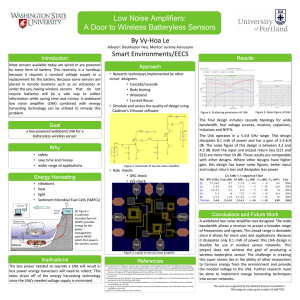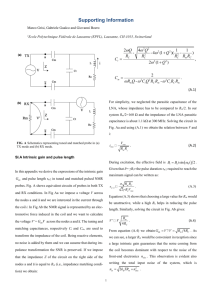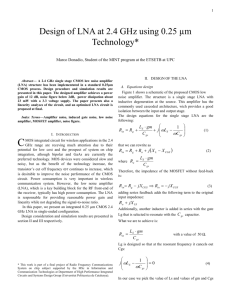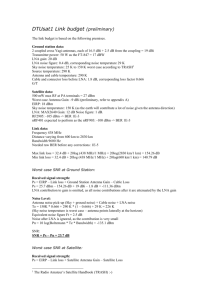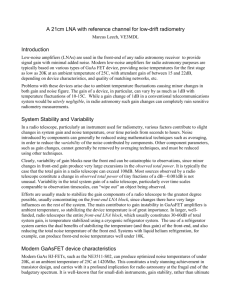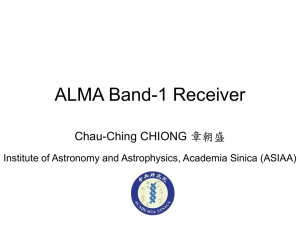Design of RF CMOS Low Noise Amplifiers Using a Current Based
advertisement
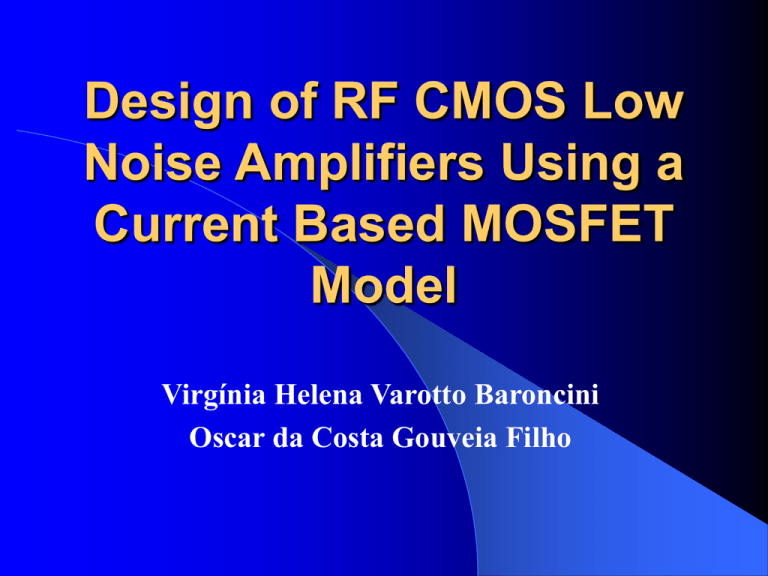
Design of RF CMOS Low Noise Amplifiers Using a Current Based MOSFET Model Virgínia Helena Varotto Baroncini Oscar da Costa Gouveia Filho OUTLINE 1. 2. 3. 4. 5. 6. Introduction MOSFET Model High-Frequency Noise Model LNA Analysis LNA Design Example Conclusion Introduction • Submicrometer CMOS technology integration of RF circuits. allows the • Low voltage and low power operation → moderate inversion • Model valid from weak to strong inversion MOSFET MODEL D I(VG,VS) G I D I F I R I VG ,VS I VG ,VD I(VG,VD) IF= forward current B IR= reverse current S ' Q IS D ' W I F R μn C ox ' 2 L nC ox T 2 T Q'IS D 2 ' nC ox T 2 Normalized currents 1 i f (r ) where and i f (r ) QIS ( D ) 1 t nC ox IF IS 2 ' t W I S .n.C ox 2 L are the normalized currents is the normalization current Operation Regions of the MOS transistor ir 103 strong 102 moderate triode reverse saturation ir > 100 if forward saturation 100 weak 10-1 weak strong 10-3 10-3 if > 100 ir 10-1 100 102 103 1 if Small signal parameters Transconductances gms 2I s t g ms gm n 1 if 1 Capacitances 2 C gs WLC ox 3 C gb 1 if 1 1 if 2 1 if 1 n 1 C gs WLCox n 2 High- Frequency Noise Model Rg G S B SvRg D gmsVsb Cgb Sig Cgs gmVgb Sid S B Channel Thermal Noise 4kTμ Q I S id L2 1 2 S id 4kTgms 3 1 i 1 f 1 i f 1 1 10-23 Sid (A2/Hz) 10-24 10-25 10-26 10-27 10-28 10-29 10-3 10-2 10-1 100 101 102 103 if Induced Gate Noise ωC 2 S ig 4kTδ gs 5gms δ ω W L C 8 S ig kT 45 μ0 nT 2 10 10 Sig(A 2 /Hz) 10 10 10 10 10 3 ' ox 1 if 1 1 if 1 if 1 -45 -46 -47 -48 -49 W /L=1000 W /L=2000 W /L=3000 W /L=4000 W /L=5000 -50 -51 10 -3 10 -2 10 -1 0 10 inversion level 10 1 10 2 10 3 4 2 2 LNA Analysis Cascode LNA with inductive source degeneration VDD Ld Vb Vin Lg M2 M1 LS Impedance Matching Lg Cgb Cgs gmbVsb Zin Z1 Z1 gmsVgs Ls 1 2 Ls C gs g m 1 jC gs 1 2 Ls C gs g m Z1 can be viewed as the parallel of a resistor R with the capacitance Cgs Simplified small signal model for the LNA Lg R 2C 1 2 Lg C R Z in j 2 2 2 1 R C 1 2 R 2C 2 matching is achieved simply by making the real part of Zin equal to the source resistance and its imaginary part equal to zero. Rs C gs C gb Ls ωT C gs Lg 1 ω02 C gb C gs Definition Noise Figure Total output noise F Total output noise due to the source LNA small-signal model for noise calculations The noise figure can be expressed as a function of if Noise figure versus W/L for several inversion levels at 2.5 GHz 4 if=15 if=20 if=25 if=30 if=35 3.5 Noise Figure (dB) 3 2.5 2 1.5 1 500 1000 1500 2000 2500 3000 W/L 3500 4000 4500 5000 LNA Design Example LNA Design Parameters Resonance frequency Supply voltage Length Source resistance Noise Figure 2,5 GHz 2,5 V 0,35 m 50 < 2dB Procedure 1. Choice of the inversion level if=35 2. Ls for impedance matching 3 n 1 L Ls RS 4 n T 2 2 1 i f 1 2 1 if 1 2 1 i f 2 1 if 2 1 if 1 3. Transistor width for minimum noise figure 4 if=15 if=20 if=25 if=30 if=35 3.5 Noise Figure (dB) 3 2.5 2 1.5 1 500 1000 1500 2000 2500 3000 W/L 3500 4000 4500 5000 Noise figure versus W/L for several inversion levels at 2.5 GHz 4. Lg to satisfy the resonance frequency Lg WLC ox 2 1 i f 2 0 ' 1 1 i 2 3n 1 3n 1 i f 1 f 2 1 if 1 5. Ld to adjust the gain and the output resonance frequency 2 LNA Design Results W/L W ID Rs Ls Lg Ld 1500 525 m 4,1 mA 50 0,7 nH 7,6 nH 2,5 nH VDD RLd Ld M1 RS Lg Vin +Vbias M2 Ls Vout CL Simulation results Input impedance Noise Figure Conclusions The main advantage of this methodology is that is valid in all regions of the operation of the MOS transistors; It is possible to move the operation point of RF devices from strong inversion to moderate inversion taking advantage of higher gm/ID ratio, without degrading the noise figure;
